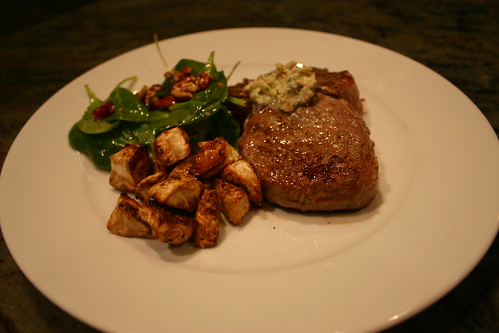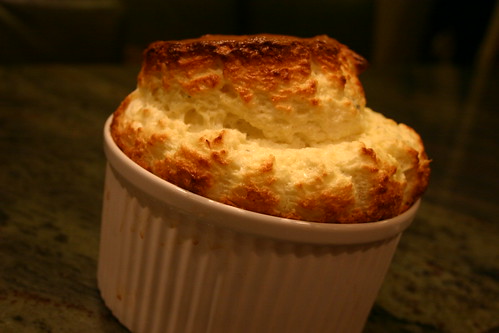
About six months ago, our household signed up for a CSA (community supported agriculture) offered by
Cedar Valley Sustainable Farm. For those of you unfamiliar with the concept, individuals and families buy a “share” in a local farm that entitles them to a box of products, most commonly produce, selected by the farmer on a periodic basis (weekly, bi-monthly or monthly). Some farmers only offer shares during the growing season, others provide them throughout the year supplementing the local product (at least in states with a limited growing season like in Illinois) with organic fruits and vegetables from California.
Signing up was a minor leap of faith given our previous, experience with CSAs. A few years back, we had ordered a weekly share from King’s Hill Farm. Foolishly, I started our deliveries in March, a few months before the growing season kicked in, so our box was full of California-grown products. This was tolerable until mid-June, at the height of strawberry season, when we were still receiving moldy mangoes as our fruit allocation.
The Cedar Valley CSA was offered through my friend Tracy Kellner’s excellent food and wine shop,
Provenance Food & Wine. With her endorsement and the ability to participate for a limited time (3 months), we signed up. Each month, we would pick up a monthly allotment of meat. Since then, we’ve purchased a second six-month term – a testament to the high quality of their product.
Typically, our share includes approximately 12 to 15 pounds of meat and between a half dozen and two dozen eggs. We’ve seen hams, finely-spiced sausages, ground beef, chops of both pork and beef and lots of chicken, at least one whole chicken a month ranging from dainty poussins to 3 plus pound roasters.
Roast chicken, as we all know, is an ideal family dinner. For most of us, it feels like a well-worn pair of jeans that flatter. It’s simple to prepare and will satisfy even a picky five-year old. Finally, it’s the gift that keeps on giving as the carcass can and should be transformed into a quick stock (recipe follows).
Here are my secrets to a well-roasted chicken:
1. Slather with butter, it browns and crisps the skin.
2. Salt more than you think is necessary. It aids in the crisping of the skin and brings out the flavor.
3. Trussing is easy – simply take a 10-inch piece of twine. Place the midway point of the twine under the tail of the chicken. Curl it around the leg bones by twisting it around the side of the bone closest to the breast. Wrap it around each leg 360° degrees and pull them close to the body. Cross the breasts, bring the twine next to the sides of the body and tie at the top. Tuck the wings under the twine as best as possible. The picture above should aid in understanding these instructions.
4. Shift the position of the chicken approximately every 15 minutes to ensure even browning. This does violate my ordinary rule of thumb, which is to open the oven as little as possible while baking or roasting - it really does aid in the even browning of the bird.
5. I follow Nigella Lawson’s formula for time, which hasn’t failed me yet. Roast the chicken for 15 minutes a pound plus 10 minutes.
Roast ChickenINGREDIENTS:
1 3 lb. chicken, preferably organic
3 tablespoons unsalted butter, softened
¼ smoked paprika (optional)
kosher or coarse sea salt and pepper to taste
1 lemon
METHOD: If you have a convection oven, preheat it to 375º F; otherwise, preheat it to 425° F. Halve the lemon and put it in the cavity. Truss the chicken according the instructions above and put it in a small roasting pan. Combine the butter and paprika and massage the chicken with it. Sprinkle with salt and pepper. Roast for about 55 minutes, until a thermometer inserted in the thickest part of the thigh reads 165° F.
You can always add garlic cloves, shallots or onions to the pan to serve the chicken. Peel them and add toss them alongside the chicken to roast with it.
GravyIf you’d like to serve the chicken with gravy, here’s my simply recipe for it.
INGREDIENTS:
1 tablespoon all purpose flour
¼ cup white wine
¼ cup chicken stock, canned is fine, homemade is better, or water
METHOD: Remove the chicken from the pan and place it on a cutting board. Cover with aluminum foil. Remove all but 1 tablespoon of fat from roasting pan. Put the pan on a burner on medium heat. Add flour and cook until lightly colored about 5 minutes. Slowly whisk in chicken stock or water and white wine, simmer until thickened. Season to taste with salt and pepper.
Chicken Stock (from carcass)INGREDIENTS:
1 chicken carcass from a roast chicken
½ carrot, peeled and sliced ½-inch thick
½ stalk celery, sliced ½-inch thick
½ onion, peeled
½ sprig thyme
½ sprig parsley
½ bay leaf
METHOD: In a large pot, cover the chicken carcass and remaining ingredients with cold water by two inches. Bring the water to a low simmer and cook for 1 hour. Let cool slightly. Strain into a large bowl and let cool, preferably over an ice bath. Refrigerate overnight to allow the fat to solidify. Remove fat and either use or apportion it into smaller containers.
For more information about Cedar Valley Farm, please visit
Local Harvest















